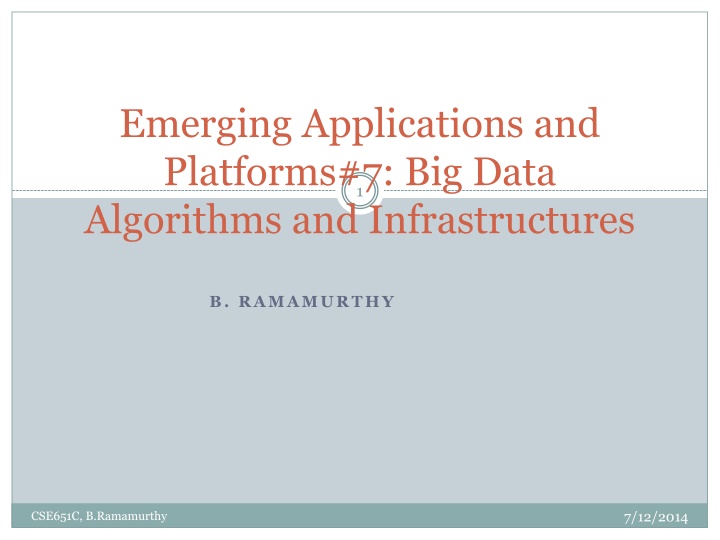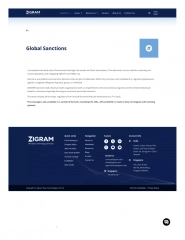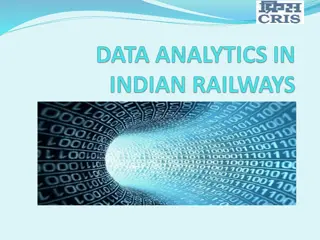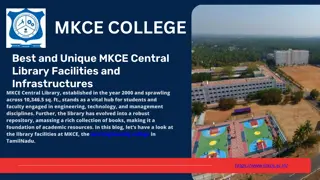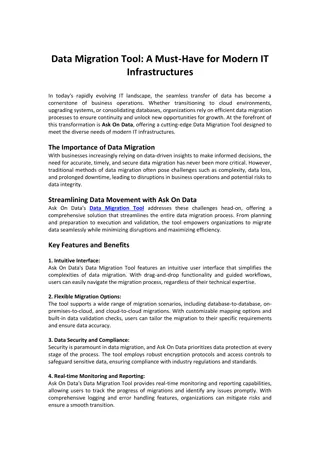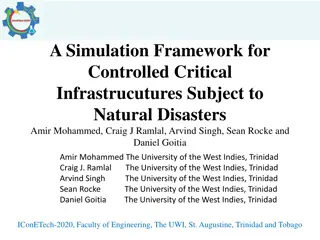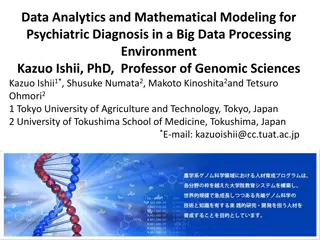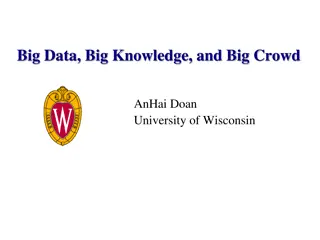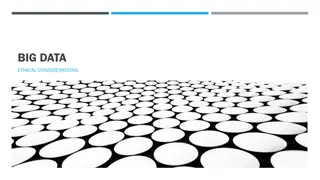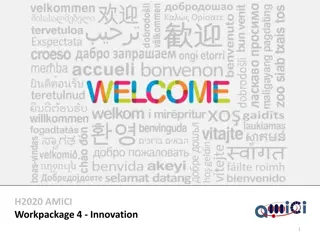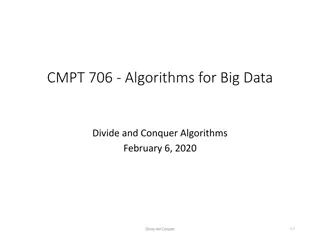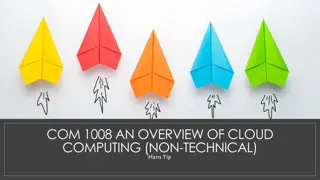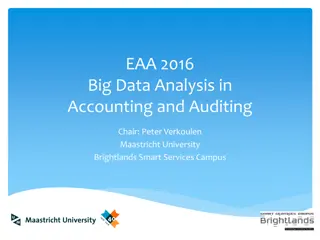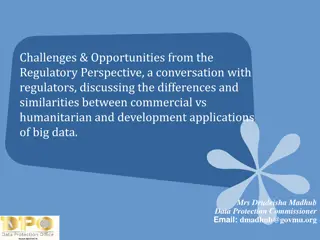Emerging Applications and Platforms#7: Big Data Algorithms and Infrastructures
This content delves into emerging applications and platforms related to big data, covering topics such as the challenges of big data computing, problem-solving approaches, data deluge from IoT devices, and the intelligence and scale of data. It discusses the characteristics of intelligent applications and the significance of processing large amounts of data for decision-making. The content also highlights the applications of big data in various sectors like finance, healthcare, and astronomy, showcasing the vast potential and implications of handling massive datasets.
Download Presentation

Please find below an Image/Link to download the presentation.
The content on the website is provided AS IS for your information and personal use only. It may not be sold, licensed, or shared on other websites without obtaining consent from the author.If you encounter any issues during the download, it is possible that the publisher has removed the file from their server.
You are allowed to download the files provided on this website for personal or commercial use, subject to the condition that they are used lawfully. All files are the property of their respective owners.
The content on the website is provided AS IS for your information and personal use only. It may not be sold, licensed, or shared on other websites without obtaining consent from the author.
E N D
Presentation Transcript
Emerging Applications and Platforms#7: Big Data Algorithms and Infrastructures 1 B. RAMAMURTHY 7/12/2014 CSE651C, B.Ramamurthy
Big-Data computing 2 What is it? Volume, velocity, variety, veracity (uncertainty) (Gartner, IBM) How is it addressed? Why now? What do you expect to extract by processing this large data? Intelligence for decision making What is different now? Storage models, processing models Big Data, analytics and cloud infrastructures Summary 7/12/2014 CSE651C, B.Ramamurthy
Big-data Problem Solving Approaches 3 Algorithmic: after all we have working towards this for ever: scalable/tracktable High Performance computing (HPC: multi-core) CCR has machines that are: 16 CPU , 32 core machine with 128GB RAM: openmp, MPI, etc. GPGPU programming: general purpose graphics processor (NVIDIA) Statistical packages like R running on parallel threads on powerful machines Machine learning algorithms on super computers Hadoop MapReduce like parallel processing. 7/12/2014 CSE651C, B.Ramamurthy
Data Deluge: smallest to largest Internet of things/devices: collecting huge amount of data from MEMS and other sensors, devices. What (else) can you do with such data? Your everyday automobile is going to be a data collecting machine that is most probably going to be stored on the cloud. Bioinformatics data: from about 3.3 billion base pairs in a human genome to huge number of sequences of proteins and the analysis of their behaviors The internet: web logs, facebook, twitter, maps, blogs, etc.: Analytics Financial applications: that analyze volumes of data for trends and other deeper knowledge Health Care: huge amount of patient data, drug and treatment data The universe: The Hubble ultra deep telescope shows 100s of galaxies each with billions of stars: Sloan Digital Sky Survey: http://www.sdss.org/ 7/12/2014 4 CSE651C, B.Ramamurthy
Intelligence and Scale of Data 5 Intelligence is a set of discoveries made by federating/processing information collected from diverse sources. Information is a cleansed form of raw data. For statistically significant information we need reasonable amount of data. For gathering good intelligence we need large amount of information. As pointed out by Jim Grey in the Fourth Paradigm book enormous amount of data is generated by the millions of experiments and applications. Thus intelligence applications are invariably data-heavy, data- driven and data-intensive. Data is gathered from the web (public or private, covert or overt), generated by large number of domain applications. 7/12/2014 CSE651C, B.Ramamurthy
Characteristics of intelligent applications 6 Google search: How is different from regular search in existence before it? It took advantage of the fact the hyperlinks within web pages form an underlying structure that can be mined to determine the importance of various pages. Restaurant and Menu suggestions: instead of Where would you like to go? Would you like to go to CityGrille ? Learning capacity from previous data of habits, profiles, and other information gathered over time. Collaborative and interconnected world inference capable: facebook friend suggestion Large scale data requiring indexing Do you know amazon is going to ship things before you order? Here 7/12/2014 CSE651C, B.Ramamurthy
Data-intensive application characteristics Models Algorithms (thinking) Data structures (infrastructure) Reference Structures (knowledge) AggregatedContent (Raw data) 7 7/12/2014 CSE651C, B.Ramamurthy
Basic Elements 8 Aggregated content: large amount of data pertinent to the specific application; each piece of information is typically connected to many other pieces. Ex: DBs Reference structures: Structures that provide one or more structural and semantic interpretations of the content. Reference structure about specific domain of knowledge come in three flavors: dictionaries, knowledge bases, and ontologies Algorithms: modules that allows the application to harness the information which is hidden in the data. Applied on aggregated content and some times require reference structure Ex: MapReduce Data Structures: newer data structures to leverage the scale and the WORM characteristics; ex: MS Azure, Apache Hadoop, Google BigTable 7/12/2014 CSE651C, B.Ramamurthy
Examples of data-intensive applications 9 Search engines Automobile design and diagnostics Recommendation systems: CineMatch of Netflix Inc. movie recommendations Amazon.com: book/product recommendations Biological systems: high throughput sequences (HTS) Analysis: disease-gene match Query/search for gene sequences Space exploration Financial analysis 7/12/2014 CSE651C, B.Ramamurthy
More intelligent data-intensive applications 10 Social networking sites Mashups : applications that draw upon content retrieved from external sources to create entirely new innovative services. Portals Wikis: content aggregators; linked data; excellent data and fertile ground for applying concepts discussed in the text Media-sharing sites Online gaming Biological analysis Space exploration 7/12/2014 CSE651C, B.Ramamurthy
Algorithms 11 Statistical inference Machine learning is the capability of the software system to generalize based on past experience and the use of these generalization to provide answers to questions related old, new and future data. Data mining Deep data mining Soft computing We also need algorithms that are specially designed for the emerging storage models and data characteristics. 7/12/2014 CSE651C, B.Ramamurthy
Different Type of Storage Internet introduced a new challenge in the form web logs, web crawler s data: large scale peta scale But observe that this type of data has an uniquely different characteristic than your transactional or the customer order data, or bank account data : The data type is write once read many (WORM) ; Privacy protected healthcare and patient information; Privacy protected healthcare and patient information; Historical financial data; Historical financial data; Other historical data Other historical data Relational file system and tables are insufficient. Large <key, value> stores (files) and storage management system. Built-in features for fault-tolerance, load balancing, data-transfer and aggregation, Clusters of distributed nodes for storage and computing. Computing is inherently parallel 7/12/2014 12 CSE651C, B.Ramamurthy
Big-data Concepts Originated from the Google File System (GFS) is the special <key, value> store Hadoop Distributed file system (HDFS) is the open source version of this. (Currently an Apache project) Parallel processing of the data using MapReduce (MR) programming model Challenges Formulation of MR algorithms Proper use of the features of infrastructure (Ex: sort) Best practices in using MR and HDFS An extensive ecosystem consisting of other components such as column-based store (Hbase, BigTable), big data warehousing (Hive), workflow languages, etc. 7/12/2014 13 CSE651C, B.Ramamurthy
Data & Analytics We have witnessed explosion in algorithmic solutions. In pioneer days they used oxen for heavy pulling, when one couldn t budge a log they didn t try to grow a larger ox. We shouldn t be trying for bigger computers, but for more systems of computers. Grace Hopper What you cannot achieve by an algorithm can be achieved by more data. Big data if analyzed right gives you better answers: Center for disease control prediction of flu vs. prediction of flu through search data 2 full weeks before the onset of flu season! http://www.google.org/flutrends/ 7/12/2014 14 CSE651C, B.Ramamurthy
Cloud Computing Cloud is a facilitator for Big Data computing and is an indispensable in this context Cloud provides processor, software, operating systems, storage, monitoring, load balancing, clusters and other requirements as a service Cloud offers accessibility to Big Data computing Cloud computing models: platform (PaaS), Microsoft Azure software (SaaS), Google App Engine (GAE) infrastructure (IaaS), Amazon web services (AWS) Services-based application programming interface (API) 7/12/2014 15 CSE651C, B.Ramamurthy
Enabling Technologies for Cloud computing 16 Web services Multicore machines Newer computation model and storage structures Parallelism 7/12/2014 CSE651C, B.Ramamurthy
Evolution of the service concept A service is a meaningful activity that a computer program performs on request of another computer program. Technical definition: A service a remotely accessible, self- contained application module. From IBM, Object/ Class Component Service CSE651C, B.Ramamurthy 7/12/2014 17
An Innovative Approach to Parallel Processing Data 18 BINA RAMAMURTHY PARTIALLY SUPPORTED BY NSF DUE GRANT: 0737243, 0920335 7/12/2014 CSE651C, B.Ramamurthy
The Context: Big-data 19 Man on the moon with 32KB (1969); my laptop had 2GB RAM (2009) Google collects 270PB data in a month (2007), 20PB a day (2008) 2010 census data is a huge gold mine of information Data mining huge amounts of data collected in a wide range of domains from astronomy to healthcare has become essential for planning and performance. We are in a knowledge economy. Data is an important asset to any organization Discovery of knowledge; Enabling discovery; annotation of data We are looking at newer programming models, and Supporting algorithms and data structures National Science Foundation refers to it as data-intensive computing and industry calls it big-data and cloud computing 7/12/2014 CSE651C, B.Ramamurthy
More context 20 Rear Admiral Grace Hopper: In pioneer days they used oxen for heavy pulling, and when one ox couldn't budge a log, they didn't try to grow a larger ox. We shouldn't be trying for bigger computers, but for more systems of computers. ---From the Wit and Wisdom of Grace Hopper (1906-1992), http://www.cs.yale.edu/homes/tap/Files/hopper- wit.html 7/12/2014 CSE651C, B.Ramamurthy
Introduction 21 Text processing: web-scale corpora (singular corpus) Simple word count, cross reference, n-grams, A simpler technique on more data beat a more sophisticated technique on less data. Google researchers call this: unreasonable effectiveness of data --Alon Halevy, Peter Norvig, and Fernando Pereira. The unreasonable effectiveness of data. Communications of the ACM, 24(2):8{12}, 2009. 7/12/2014 CSE651C, B.Ramamurthy
MapReduce 22 7/12/2014 CSE651C, B.Ramamurthy
What is MapReduce? 23 MapReduce is a programming model Google has used successfully in processing its big-data sets (~ 20 peta bytes per day in 2008) Users specify the computation in terms of a map and a reduce function, Underlying runtime system automatically parallelizes the computation across large-scale clusters of machines, and Underlying system also handles machine failures, efficient communications, and performance issues. -- Reference: Dean, J. and Ghemawat, S. 2008. MapReduce: simplified data processing on large clusters.Communication of ACM 51, 1 (Jan. 2008), 107-113. 7/12/2014 CSE651C, B.Ramamurthy
Big idea behind MR 24 Scale-out and not scale-up: Large number of commodity servers as opposed large number of high end specialized servers Economies of scale, ware-house scale computing MR is designed to work with clusters of commodity servers Research issues: Read Barroso and Holzle s work Failures are norm or common: With typical reliability, MTBF of 1000 days (about 3 years), if you have a cluster of 1000, probability of at least 1 server failure at any time is nearly 100% 7/12/2014 CSE651C, B.Ramamurthy
Big idea (contd.) 25 Moving processing to the data: not literally, data and processing are co-located versus sending data around as in HPC Process data sequentially vs random access: analytics on large sequential bulk data as opposed to search for one item in a large indexed table Hide system details from the user application: user application does not have to get involved in which machine does what. Infrastructure can do it. Seamless scalability: Can add machines / server power without changing the algorithms: this is in-order to process larger data set 7/12/2014 CSE651C, B.Ramamurthy
Issues to be addressed 26 How to break large problem into smaller problems? Decomposition for parallel processing How to assign tasks to workers distributed around the cluster? How do the workers get the data? How to synchronize among the workers? How to share partial results among workers? How to do all these in the presence of errors and hardware failures? MR is supported by a distributed file system that addresses many of these aspects. 7/12/2014 CSE651C, B.Ramamurthy
MapReduce Basics 27 Fundamental concept: Key-value pairs form the basic structure of MapReduce <key, value> Key can be anything from a simple data types (int, float, etc) to file names to custom types. Examples: <docid, docitself> <yourName, yourLifeHistory> <graphNode, nodeCharacteristicsComplexData> <yourId, yourFollowers> <word, itsNumofOccurrences> <planetName, planetInfo> <geneNum, <{pathway, geneExp, proteins}> <Student, stuDetails> 7/12/2014 CSE651C, B.Ramamurthy
From CS Foundations to MapReduce (Example#1) 28 Consider a large data collection: {web, weed, green, sun, moon, land, part, web, green, } Problem: Count the occurrences of the different words in the collection. Lets design a solution for this problem; We will start from scratch We will add and relax constraints We will do incremental design, improving the solution for performance and scalability 7/12/2014 CSE651C, B.Ramamurthy
Word Counter and Result Table 29 {web, weed, green, sun, moon, land, part, web, green, } web 2 weed 1 green 2 Data Main sun 1 collection moon 1 land 1 part 1 WordCounter parse( ) count( ) ResultTable DataCollection 7/12/2014 CSE651C, B.Ramamurthy
Multiple Instances of Word Counter 30 web 2 weed 1 green 2 Data Main sun 1 collection moon 1 Thread land 1 1..* 1..* WordCounter part 1 parse( ) count( ) Observe: Multi-thread Lock on shared data DataCollection ResultTable 7/12/2014 CSE651C, B.Ramamurthy
Improve Word Counter for Performance 31 No need for lock N Main web o 2 weed 1 Data green 2 collection sun 1 moon 1 Thread land 1 1..* 1..* part 1 1..* 1..* Counter Parser Separate counters WordList DataCollection ResultTable KEY web weed green sun moon land part web green . VALUE 7/12/2014 CSE651C, B.Ramamurthy
Peta-scale Data 32 Main web 2 weed 1 green 2 Data sun 1 collection moon 1 Thread land 1 1..* 1..* part 1 1..* 1..* Counter Parser WordList DataCollection ResultTable KEY web weed green sun moon land part web green . VALUE 7/12/2014 CSE651C, B.Ramamurthy
Addressing the Scale Issue 33 Single machine cannot serve all the data: you need a distributed special (file) system Large number of commodity hardware disks: say, 1000 disks 1TB each Issue: With Mean time between failures (MTBF) or failure rate of 1/1000, then at least 1 of the above 1000 disks would be down at a given time. Thus failure is norm and not an exception. File system has to be fault-tolerant: replication, checksum Data transfer bandwidth is critical (location of data) Critical aspects: fault tolerance + replication + load balancing, monitoring Exploit parallelism afforded by splitting parsing and counting Provision and locate computing at data locations 7/12/2014 CSE651C, B.Ramamurthy
Peta-scale Data 34 Main web 2 weed 1 green 2 Data sun 1 collection moon 1 Thread land 1 1..* 1..* part 1 1..* 1..* Counter Parser WordList DataCollection ResultTable KEY web weed green sun moon land part web green . VALUE 7/12/2014 CSE651C, B.Ramamurthy
Peta Scale Data is Commonly Distributed Data collection 35 Main web 2 Data collection weed 1 green 2 Data sun 1 collection moon 1 Thread land 1 1..* 1..* Data part 1 1..* 1..* collection Counter Parser WordList Data DataCollection ResultTable collection Issue: managing the large scale data KEY web weed green sun moon land part web green . VALUE 7/12/2014 CSE651C, B.Ramamurthy
Write Once Read Many (WORM) data Data collection 36 Main web 2 Data collection weed 1 green 2 Data sun 1 collection moon 1 Thread land 1 1..* 1..* Data part 1 1..* 1..* collection Counter Parser WordList Data DataCollection ResultTable collection KEY web weed green sun moon land part web green . VALUE 7/12/2014 CSE651C, B.Ramamurthy
WORM Data is Amenable to Parallelism Data collection 37 Main Data collection 1. Data with WORM characteristics : yields to parallel processing; 2. Data without dependencies: yields to out of order processing Data collection Thread 1..* 1..* Data 1..* 1..* collection Counter Parser WordList Data DataCollection ResultTable collection 7/12/2014 CSE651C, B.Ramamurthy
Divide and Conquer: Provision Computing at Data Location 38 For our example, #1: Schedule parallel parse tasks #2: Schedule parallel count tasks This is a particular solution; Lets generalize it: Main Data Thread collection 1..* 1..* 1..* 1..* Counter Parser One node WordList DataCollection ResultTable Main Our parse is a mapping operation: MAP: input <key, value> pairs Data Thread collection 1..* 1..* 1..* 1..* Counter Parser WordList DataCollection ResultTable Our count is a reduce operation: REDUCE: <key, value> pairs reduced Main Data Thread collection 1..* 1..* 1..* 1..* Counter Map/Reduce originated from Lisp But have different meaning here Parser WordList DataCollection ResultTable Main Runtime adds distribution + fault tolerance + replication + monitoring + load balancing to your base application! Data Thread collection 1..* 1..* 1..* 1..* Counter Parser WordList DataCollection ResultTable 7/12/2014 CSE651C, B.Ramamurthy
Mapper and Reducer 39 MapReduceTask Mapper Reducer Counter YourReducer Parser YourMapper Remember: MapReduce is simplified processing for larger data sets 7/12/2014 CSE651C, B.Ramamurthy
Map Operation 40 weed 1 MAP: Input data <key, value> pair weed 1 green 1 web 1 sun 1 weed 1 moon 1 green 1 land 1 sun 1 web 1 land 1 Map moon 1 weed 1 web 1 land web 1 1 Data green 1 green 1 part weed 1 1 Split the data to Supply multiple processors sun 1 Collection: split1 web 1 1 web green 1 1 moon 1 weed 1 KEY VALUE land green sun 1 1 1 green 1 web moon 1 1 part 1 sun 1 KEY land VALUE 1 web 1 moon 1 part 1 green 1 Map Data land 1 web 1 green 1 part 1 Collection: split 2 green 1 KEY VALUE web 1 1 green 1 KEY VALUE part 1 KEY VALUE Data Collection: split n 7/12/2014 CSE651C, B.Ramamurthy
MapReduce Example #2 41 part0 map combine reduce Cat split part1 map reduce combine split Bat part2 map combine reduce split Dog map split Other Words (size: TByte) barrier 7/12/2014 CSE651C, B.Ramamurthy
MapReduce Design 42 You focus on Map function, Reduce function and other related functions like combiner etc. Mapper and Reducer are designed as classes and the function defined as a method. Configure the MR Job for location of these functions, location of input and output (paths within the local server), scale or size of the cluster in terms of #maps, # reduce etc., run the job. Thus a complete MapReduce job consists of code for the mapper, reducer, combiner, and partitioner, along with job configuration parameters. The execution framework handles everything else. The way we configure has been evolving with versions of hadoop. 7/12/2014 CSE651C, B.Ramamurthy
The code 43 1: class Mapper 2: method Map(docid a; doc d) 3: for all term t in doc d do 4: Emit(term t; count 1) 1: class Reducer 2: method Reduce(term t; counts [c1; c2; : : :]) 3: sum = 0 4: for all count c in counts [c1; c2; : : :] do 5: sum = sum + c 6: Emit(term t; count sum) 7/12/2014 CSE651C, B.Ramamurthy
Problem#2 44 This is a cat Cat sits on a roof The roof is a tin roof There is a tin can on the roof Cat kicks the can It rolls on the roof and falls on the next roof The cat rolls too It sits on the can 7/12/2014 CSE651C, B.Ramamurthy
MapReduce Example: Mapper 45 This is a cat Cat sits on a roof <this 1> <is 1> <a 1> <cat 1> <cat 1> <sits 1> <on 1><a 1> <roof 1> The roof is a tin roof There is a tin can on the roof <the 1> <roof 1> <is 1> <a 1> <tin 1 ><roof 1> <there 1> <is 1> <a 1> <tin 1><can 1> <on 1><the 1> <roof 1> Cat kicks the can It rolls on the roof and falls on the next roof <cat 1> <kicks 1> <the 1><can 1> <it 1> <rolls 1> <on 1> <the 1> <roof 1> <and 1> <falls 1><on 1> <the 1> <next 1> <roof 1> The cat rolls too It sits on the can <the 1> <cat 1> <rolls 1> <too 1> <it 1> <sits 1> <on 1> <the 1> <can 1> 7/12/2014 CSE651C, B.Ramamurthy
MapReduce Example: Shuffle to the Reducer 46 Output of Mappers: <this 1> <is 1> <a 1> <cat 1> <cat 1> <sits 1> <on 1><a 1> <roof 1> <the 1> <roof 1> <is 1> <a 1> <tin 1 ><roof 1> <there 1> <is 1> <a 1> <tin 1><can 1> <on 1><the 1> <roof 1> <cat 1> <kicks 1> <the 1><can 1> <it 1> <rolls 1> <on 1> <the 1> <roof 1> <and 1> <falls 1><on 1> <the 1> <next 1> <roof 1> <the 1> <cat 1> <rolls 1> <too 1> <it 1> <sits 1> <on 1> <the 1> <can 1> Input to the reducer: delivered sorted... By key .. <can <1, 1>> <cat <1,1,1,1>> <roof <1,1,1,1,1,1>> .. Reduce (sum in this case) the counts: comes out sorted!!! .. <can 2> <cat 4> .. <roof 6> 7/12/2014 CSE651C, B.Ramamurthy
More on MR 47 All Mappers work in parallel. Barriers enforce all mappers completion before Reducers start. Mappers and Reducers typically execute on the same machine You can configure job to have other combinations besides Mapper/Reducer: ex: identify mappers/reducers for realizing sort (that happens to be a Benchmark) Mappers and reducers can have side effects; this allows for sharing information between iterations. 7/12/2014 CSE651C, B.Ramamurthy
MapReduce Characteristics 48 Very large scale data: peta, exa bytes Write once and read many data: allows for parallelism without mutexes Map and Reduce are the main operations: simple code There are other supporting operations such as combine and partition: we will look at those later. Operations are provisioned near the data. Commodity hardware and storage. Runtime takes care of splitting and moving data for operations. Special distributed file system: Hadoop Distributed File System and Hadoop Runtime. 7/12/2014 CSE651C, B.Ramamurthy
Classes of problems mapreducable 49 Benchmark for comparing: Jim Gray s challenge on data- intensive computing. Ex: Sort Google uses it (we think) for wordcount, adwords, pagerank, indexing data. Simple algorithms such as grep, text-indexing, reverse indexing Bayesian classification: data mining domain Facebook uses it for various operations: demographics Financial services use it for analytics Astronomy: Gaussian analysis for locating extra-terrestrial objects. Expected to play a critical role in semantic web and web3.0 7/12/2014 CSE651C, B.Ramamurthy
Scope of MapReduce 50 Data size: small Pipelined Instruction level Concurrent Thread level Service Object level Indexed File level Mega Block level Virtual System Level Data size: large 7/12/2014 CSE651C, B.Ramamurthy
